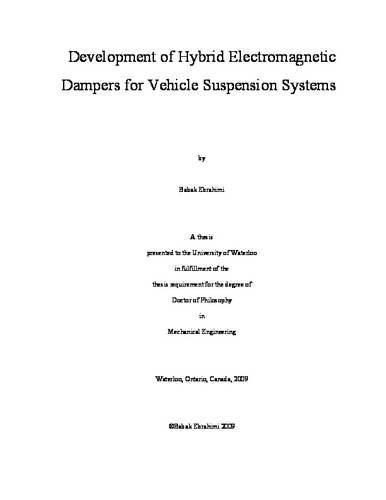| dc.description.abstract | Vehicle suspension systems have been extensively explored in the past decades, contributing to ride comfort, handling and safety improvements. The new generation of powertrain and propulsion systems, as a new trend in modern vehicles, poses significant challenges to suspension system design. Consequently, novel suspension concepts are required, not only to improve the vehicle’s dynamic performance, but also to enhance the fuel economy by utilizing regeneration functions. However, the development of new-generation suspension systems necessitates advanced suspension components, such as springs and dampers. This Ph.D. thesis, on the development of hybrid electromagnetic dampers is an Ontario Centres of Excellence (OCE) collaborative project sponsored by Mechworks Systems Inc. The ultimate goal of this project is to conduct feasibility study of the development of electromagnetic dampers for automotive suspension system applications.
With new improvements in power electronics and magnetic materials, electromagnetic dampers are forging the way as a new technology in vibration isolation systems such as vehicle suspension systems. The use of electromagnetic dampers in active vehicle suspension systems has drawn considerable attention in the recent years, attributed to the fact that active suspension systems have superior performance in terms of ride comfort and road-handling performances compared to their passive and semi-active counterparts in automotive applications. As a response to the expanding demand for superior vehicle suspension systems, this thesis describes the design and development of a new electromagnetic damper as a customized linear permanent magnet actuator to be used in active suspension systems. The proposed electromagnetic damper has energy harvesting capability. Unlike commercial passive/semi-active dampers that convert the vibration kinetic energy into heat, the dissipated energy in electromagnetic dampers can be regenerated as useful electrical energy. Electromagnetic dampers are used in active suspension systems, where the damping coefficient is controlled rapidly and reliably through electrical manipulations. Although demonstrating superb performance, active suspensions still have some issues that must be overcome. They have high energy consumption, weight, and cost, and are not fail-safe in case of a power break-down. Since the introduction of the electromagnetic dampers, the challenge was to address these drawbacks.
Hybrid electromagnetic dampers, which are proposed in this Ph.D. thesis, are potential solutions to high weight, high cost, and fail-safety issues of an active suspension system. The hybrid electromagnetic damper utilizes the high performance of an active electromagnetic damper with the reliability of passive dampers in a single package, offering a fail-safe damper while decreasing weight and cost. Two hybrid damper designs are proposed in this thesis. The first one operates based on hydraulic damping as a source of passive damping, while the second design employs the eddy current damping effect to provide the passive damping part of the system. It is demonstrated that the introduction of the passive damping can reduce power consumption and weight in an active automotive suspension system.
The ultimate objective of this thesis is to employ existing suspension system and damper design knowledge together with new ideas from electromagnetic theories to develop new electromagnetic dampers. At the same time, the development of eddy current dampers, as a potential source for passive damping element in the final hybrid design, is considered and thoroughly studied. For the very first time, the eddy current damping effect is introduced for the automotive suspension applications. The eddy current passive damper, as a stand-alone unit, is designed, modeled, fabricated and successfully tested. The feasibility of using passive eddy current dampers for automotive suspension applications is also studied. The structure of new passive eddy current dampers is straightforward, requiring no external power supply or any other electronic devices. Proposed novel eddy current dampers are oil-free and non-contact, offering high reliability and durability with their simplified design.
To achieve the defined goals, analytical modeling, numerical simulations, and lab-based experiments are conducted. A number of experimental test-beds are prepared for various experimental analyses on the fabricated prototypes as well as off-the-shelf dampers. Various prototypes, such as eddy current and electromagnetic dampers, are manufactured, and tested in frequency/time domains for verification of the derived analytical and numerical models, and for proof of concept. In addition, fluid and heat transfer analyses are done during the process of the feasibility study to ensure the durability and practical viability of the proposed hybrid electromagnetic dampers.
The presented study is only a small portion of the growing research in this area, and it is hoped that the results obtained here will lead to the realization of a safer and more superior automotive suspension system. | en |

